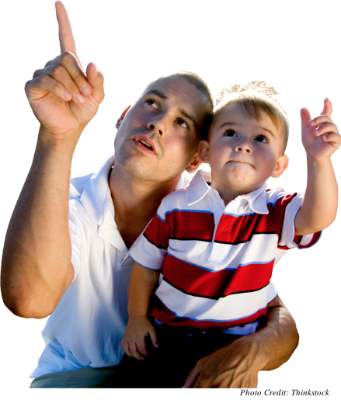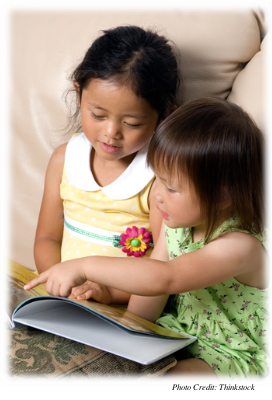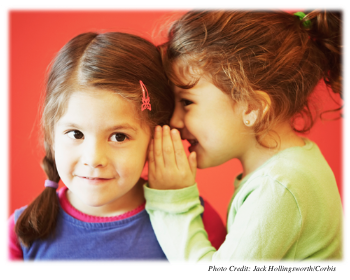Language Development in Early Childhood
Slide 1 of 12: Synopsis

Author
S. Stavros Valenti, Hofstra University
Synopsis
Learning language is a tremendous source of pride and enjoyment for children. It gives them greater control over their environment and a greater connection to others. In this activity, you will observe how dramatically children’s language skills grow between the ages of two and six, and you will explore some of the reasons why children everywhere learn language so quickly and effortlessly.
References
Cole, M., & Cole, S. (2001). The development of children (4th ed.). New York: Worth Publishers.
Berger, K. S. (2001). The developing person through the life span (4th ed.). New York: Worth Publishers.
Pinker, S. (1994). The language instinct. New York: William Morrow and Company.
Slide 2 of 12: Building a Vocabulary
- Chapters
- descriptions off, selected
- captions settings, opens captions settings dialog
- captions off, selected
- English Captions
This is a modal window.
Beginning of dialog window. Escape will cancel and close the window.
End of dialog window.
This is a modal window. This modal can be closed by pressing the Escape key or activating the close button.
This is a modal window.
Learning words, at first, is a slow and effortful process. In the six months after their first birthday, many children have learned to speak only about 50 words. That is less than 10 words a month. The pace picks up at around 18 months, and by their second birthday, most children will be acquiring about 10 words a day!
Play the video to hear some examples of early words.
Slide 3 of 12: Fast-Mapping

What enables children to learn new words so quickly? One explanation is that once the child has an initial set of mental categories and words for objects and events in the world, she can quickly form an initial sense of a new word. For example, the young language learner might determine that the new word is a kind of animal (“A cheetah is running with the lion.”) or a color term (“Now, get the red cup.”) by contrasting the new word with familiar words. In a sense, the familiar categories and words constitute an internal grid onto which new words can be placed, or mapped. Upon hearing a new word in the context of familiar ones, the child is likely to connect the new word to the new object, event, or attribute in her environment. This process is called fast‐mapping.
In addition to these assumptions, children trying to understand the meaning of a new word also look for clues in the social context. For example, if an adult is looking in the direction of an object while saying a new word, the child often assumes that the new name goes with the new object.
Slide 4 of 12: Early Errors in Word Use

The cognitive principles, or assumptions about word meanings, that a new language learner applies usually help the child to use new words after hearing them a few times, or even only once! However, sometimes these good guesses are wrong. For example, a child may underextend (or “undergeneralize”) a word and insist that an “ant” is not an “animal” because the child is not appreciating just yet that “animal” is a very large category that contains many sub‐categories, including both “insect” and “ant.” In addition, a child will sometimes overextend (or “overgeneralize”) a word, such as when she calls a “goat” a “dog” because of the rough similarity in shape, size, and behavior.
Slide 5 of 12: Learning Grammatical Rules
- Chapters
- descriptions off, selected
- captions settings, opens captions settings dialog
- captions off, selected
- English Captions
This is a modal window.
Beginning of dialog window. Escape will cancel and close the window.
End of dialog window.
This is a modal window. This modal can be closed by pressing the Escape key or activating the close button.
This is a modal window.
As psychologist Steven Pinker says, children become “grammar geniuses” by their third birthday. Between ages two and three, most children are rapidly acquiring the use of grammatical morphemes, which are the little words and word endings, such as “on,” “in,” “‐ed,” “‐ing,” “‐’s,” that older children and adults use to clarify the meaning of a sentence. For example, an adult may not understand when a two‐year‐old says “daddy hat,” but there is no misunderstanding a three‐year‐old who says “That is Daddy’s hat!”
Play the video to hear speech samples from two‐year‐olds and three‐year‐olds.
Slide 6 of 12: Components of Language Development

Although there is no one accepted theory of language development, most researchers share the belief that language development is dependent on two general factors:
- Regular opportunities for social interaction. Children need to hear, or see in the case of hearing impaired children, language. They need to be part of social interactions in which language is used in order to acquire and practice grammar and vocabulary.
- An inherited capacity for language. The human brain is designed to grow into a language organ just as the heart is designed to grow into a blood circulation organ. Some of the grammatical errors that children make support the view that language has a biologic component. For example, a young toddler may say, “He holded the bunny.” Since the past tense of “hold” is the irregular “held,” this sentence is not one that this child would have heard an adult use. This error, called overregularization, reveals an automatic, perhaps biologically‐based, tendency to add “‐ed” to a verb when wanting to indicate past tense. In this example, the child has not learned or remembered that “hold” takes an irregular form for past tense. This error is exactly the kind of mistake that you would expect if children are biologically programmed to learn and apply language rules.
Slide 7 of 12: Developing True Conversational Skills
- Chapters
- descriptions off, selected
- captions settings, opens captions settings dialog
- captions off, selected
- English Captions
This is a modal window.
Beginning of dialog window. Escape will cancel and close the window.
End of dialog window.
This is a modal window. This modal can be closed by pressing the Escape key or activating the close button.
This is a modal window.
Children’s speaking competence improves dramatically in the first years of early childhood, but they still are not good at conversation. Much of what two‐ and three‐year‐old children say is actually directed to themselves. This private speech is how young children may control their own behavior when faced with various challenges. At other times, a group of young children may all talk at the same time without much regard for what others are saying or thinking, which demonstrates a form of speech called collective monologue.
From five years of age on, children develop as speakers and listeners in ways that begin to allow them to truly converse. They master more complex grammatical forms, such as the passive construction (The dog was chased by the cat.). They begin to understand that words can have multiple meanings (e.g., bark to mean what a dog does or what covers a tree trunk) and that the same object can have more than one name (turtle or terrapin or tortoise). This deeper understanding of words, in addition to improvements in knowledge, memory, and attention, helps these children to become much better conversationalists.
Play the video to hear the conversational skills of more experienced talkers.
Slide 8 of 12: Summary

The development of language in children between the ages of two and six is nothing short of astonishing. They learn new words, acquire grammatical skills, and develop the ability to participate in meaningful conversations. This is possible because they come to the task of language acquisition with a variety of built‐in skills and assets, namely, an inherited capacity to acquire grammar and the cognitive skills to help them to guess correctly at the meanings of new words. They also benefit from their interactions with adults and other children, both of whom provide opportunities and incentive for developing and practicing their language skills.
Slide 9 of 12: Assessment: Check Your Understanding

Slide 10 of 12: Assessment: Check Your Understanding

Slide 11 of 12: Assessment: Check Your Understanding

Slide 12 of 12: Assessment: Check Your Understanding

Congratulations! You have completed this activity.Total Score: x out of x points (x%) You have received a provisional score for your essay answers, which have been submitted to your instructor.